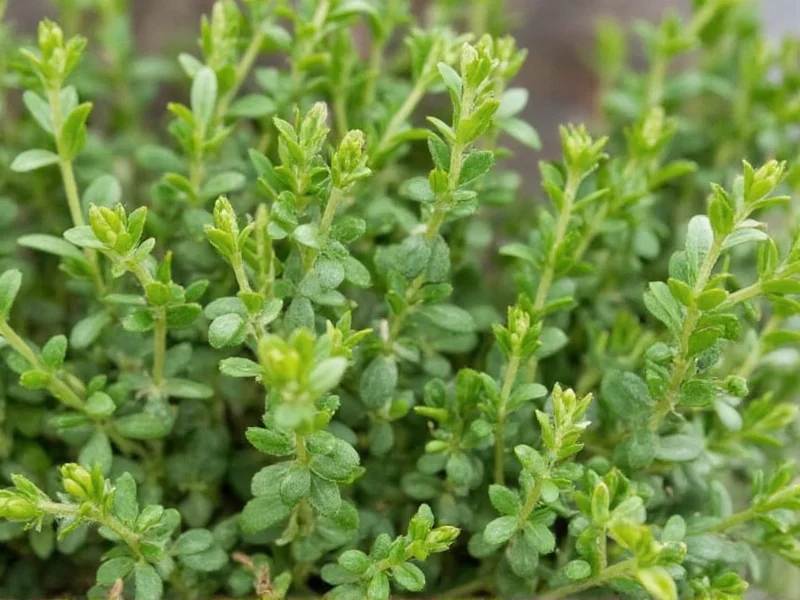Understanding herb measurements is crucial for perfect seasoning in recipes. When a recipe calls for what is a sprig of thyme, you're getting specific instructions about both quantity and preparation method. This small stem segment with attached leaves delivers distinctive flavor without overwhelming your dish.
Understanding Thyme Measurements
Many home cooks struggle with how much thyme is in a sprig because herb sizes vary. A standard thyme sprig measures 2-4 inches from stem tip to base and contains multiple small leaves along its length. The exact amount depends on:
- Thyme variety (English, French, lemon)
- Plant maturity and growing conditions
- Time of harvest
Professional chefs typically remove leaves from the stem before adding to dishes, while many recipes instruct you to add the whole sprig for slow cooking then remove before serving. This technique infuses flavor gradually without making the dish too herbal.
Practical Measurement Guide
When you need precise sprig of thyme measurement for recipe accuracy, use this reference:
| Thyme Form | Equivalent to 1 Sprig | Best For |
|---|---|---|
| Fresh thyme sprig | 2-4 inch stem with leaves | Braising, stews, roasts |
| Fresh thyme leaves | ¼-½ teaspoon | Sauces, dressings, quick dishes |
| Dried thyme | ⅛ teaspoon | Dry rubs, long-cooking dishes |
| Thyme extract | 2-3 drops | Precise flavor control |
Culinary Applications of Thyme Sprigs
Knowing how to use thyme sprigs in cooking transforms your dishes. Whole sprigs work best in:
- Braised meats - Add during cooking, remove before serving
- Stocks and broths - Infuses flavor without bitterness
- Roasted vegetables - Tuck sprigs among potatoes or root vegetables
- Compound butters - Mix chopped leaves into softened butter
For delicate dishes like sauces or dressings, strip leaves from the stem and chop finely. The woody stem doesn't soften during cooking and can be unpleasant to eat. When substituting dried thyme for fresh, remember the fresh thyme to dried thyme conversion is typically 3:1 since dried herbs concentrate flavor.
Substitution Guidance
If your recipe specifies what does a sprig of thyme look like but you only have dried thyme, use this conversion guide:
- 1 fresh sprig = ⅛ teaspoon dried thyme
- 1 tablespoon fresh thyme leaves = 1 teaspoon dried thyme
- 4-6 fresh sprigs = 1 teaspoon fresh thyme leaves
When substituting other herbs, rosemary makes the closest alternative for robust dishes, while oregano works better for Mediterranean recipes. Remember that thyme sprig equivalent measurements aren't exact science—taste as you cook and adjust according to your preference and the specific dish requirements.
Practical Tips for Handling Thyme
Maximize your thyme's flavor with these professional techniques:
- Proper storage - Keep fresh thyme wrapped in slightly damp paper towel inside airtight container in refrigerator (lasts 10-14 days)
- Leaf removal - Run fingers down stem from top to bottom to strip leaves efficiently
- Drying method - Hang bunches upside down in cool, dark place for 1-2 weeks
- Freezing option - Chop leaves and freeze in olive oil cubes for ready-to-use portions
Avoid common mistakes like using the entire woody stem in finished dishes or substituting dried thyme 1:1 for fresh. Understanding how to substitute thyme in recipes properly ensures balanced flavor without overpowering your creation. When in doubt, start with less—you can always add more thyme, but you can't remove it once added.
Frequently Asked Questions
How many teaspoons is a sprig of thyme?
One sprig of thyme equals approximately ¼ to ½ teaspoon of fresh thyme leaves. If using dried thyme as a substitute, use about ⅛ teaspoon per sprig called for in the recipe. The exact amount varies based on thyme variety and stem size.
Can I leave thyme sprigs in my dish while cooking?
Yes, you can leave whole thyme sprigs in dishes that cook for extended periods like stews, braises, or stocks. Remove the sprigs before serving as the woody stems become unpleasant to eat. For quick-cooking dishes, strip the leaves from the stem before adding to ensure proper texture.
What's the difference between fresh and dried thyme measurements?
Dried thyme is more concentrated than fresh. The standard conversion is 1 teaspoon dried thyme equals 1 tablespoon fresh thyme leaves, or approximately 4-6 sprigs. Always start with less dried thyme than you think you need, as its flavor intensifies during cooking.
How do I properly strip thyme leaves from the stem?
Hold the sprig at the top with one hand. Using your other hand, pinch the stem between thumb and forefinger just below the leaves. Slide your fingers down the stem toward the base, stripping leaves as you go. The leaves should easily detach from the woody stem.
Can I substitute other herbs for thyme sprigs?
Rosemary makes the closest substitute for thyme in robust dishes like roasts and stews, though it has a stronger flavor. Oregano works well in Mediterranean recipes. For delicate dishes, marjoram provides similar flavor with less intensity. Remember to adjust quantities as substitute herbs vary in potency.











 浙公网安备
33010002000092号
浙公网安备
33010002000092号 浙B2-20120091-4
浙B2-20120091-4